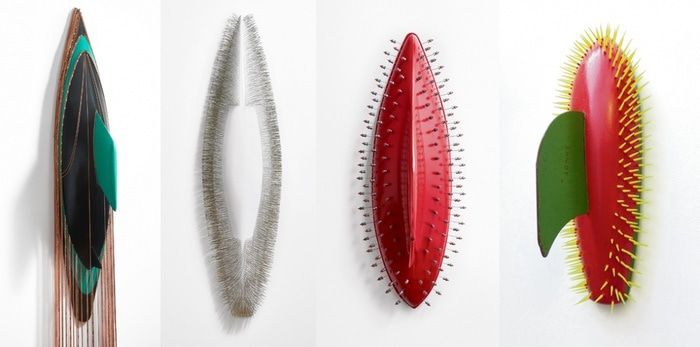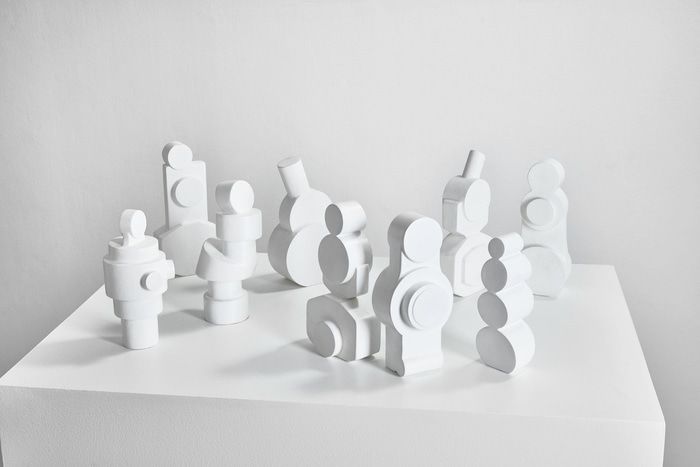Interview | Hidden Meanings with L.R. Vandy
By Ruby Fischer
The October Gallery
UNIQUE COMBINATIONS: (Left to right from top) Black, Green and Copper, Guardian, Red Dart, Red and Yellow; LR Vandy (centre) and (bottom) These
Women 02, 12, 09 and Superhero Cog Woman Courtesy of the Artist and October Gallery
LR VANDY stands at the centre of the October Gallery’s light-filled room, her brow furrowed at a sculpture on the wall beside her. It’s a two-metre long model sailing boat upended so that its black-and-green V-shaped hull, adorned with sleek copper chains, faces the middle of the room. With a deft hand, she tugs at a chain which has shifted out of place. The correction is imperceptible but she’s insistent: “If you look closely you’ll know, because it’s not symmetrical,” she tells me.
The sculpture Black, Green and Copper is just one of 19 in this latest
installation of Vandy’s signature Hull series, in which she transforms model
boats into talismanic and mask-like sculptures, meticulously piercing each hull with hundreds of air darts, fishing floats, needles, brass tacks or colourful beads which radiate from the forms in intricately plotted patterns.
Inspiration struck when Vandy came across an old unrigged model sailing boat at a car-boot sale. “When I turned it over, I saw the face immediately,” she says, and indeed in every piece there’s the suggestion of a human face, the keel splitting the forms in two like a nose. It’s this eye for balance that makes Hidden, Vandy’s first solo show, so challenging. There is visual harmony, from the streamlined hulls on the walls to the minute bronze and
jesmonite sculptures gathered in the centre of the gallery, with a dignified symmetry to every piece she makes.
Lisa Vandy in her studio. Courtesy of the Artist and October Gallery
But there’s also a hidden equipoise to the message itself. “It’s about creating a tension in that beauty by also talking about deeply tragic events,”
Vandy says, referring particularly to the Atlantic slave trade and the contemporary migrant crisis. It’s a tension that lives at the heart of this ambitious exhibition, which exists between beauty and monstrosity, romance and tragedy, pain and power.
Often the tension is overt, as in Red Dart, in which a small, cherry-red figure is pierced with red air-gun pellets that protrude from its body like a scattering of blood-tipped spears. “I’ve always imagined them as land mines,” says Vandy, once again stepping back to consider her work. “To
me it’s that sense of navigating something dangerous.”
Other hulls, like Red and Yellow are simply fun. Bright bodies spiked with neon beads perch like splendid urchins on the walls, their squat figures
setting a quirky counterpoint to the grandeur of the larger works. Apart from reflecting a little of Vandy’s own playful sense of adventure, there’s a
purpose in the levity. “There’s got to be humour,” she says. “It’s too painful otherwise.“
Once or twice, Vandy refers to the hulls as “she” or “her” because “boats are women,” and indeed there’s no denying the yonic symbolism of the
upturned boats. “It took me three hulls before I saw the vulva,” she confesses. “But there was a beautiful incident at 1-54 [the contemporary African art fair in New York] when certain more mature women looked at
me and gave me a wink because they’d seen the very thing, the Wall of Cunts!” Under this lens, Guardian — pure white and framed by outward-facing acupuncture needles — recalls the Ainu legends of sharp-toothed vaginas castrating unwitting grooms. It’s immensely satisfying.
While Vandy doesn’t consider her work to be solely informed by her Nigerian heritage, her art is infused with a form and political content that
feels distinctly African. Indeed, she’s placed by those who know her in the vanguard of a revolution in the contemporary African art world.
For Vandy, the question of identity is more closely woven with her British
upbringing. She recounts a recent conversation with author Jeanette Winterson, during which she articulates the complex notions of ownership and belonging behind her racing boat/mask figures: “The people that made
these things are the very people whose houses I was not allowed to go round to,” she says.
“I was being kicked out of people’s gardens come four o’clock because dad was coming home and didn’t want to see black people in his garden. So it feels like a kind of reclamation.”
Lisa Vandy, These Women Series, Courtesy of the Artist and October Gallery
Other works featured in Hidden include These Women, a tabletop of geometric sculptures which conjures the age of cogs, discs, wheels and pistons. Form, married with function, imagines a shared and industrious womanhood, each figure made up of the same disparate parts arranged in unique combinations. “Women are the engines of society!” Vandy exclaims, “and I’m a fan of a cog and a gear.” Outside in the gallery courtyard, we gaze at another of the engine-women, a two-metre-high incarnation of
one of her miniature sisters, Superhero Cog Woman.
“I’ve got to go into this as me, just me,” Vandy says as the day comes to a
close. “It’s exhausting to be something you’re not. So, you know, I’m not cool, I talk a lot. I can be annoying. But my pledge to myself is to not step
outside of who I am.”


